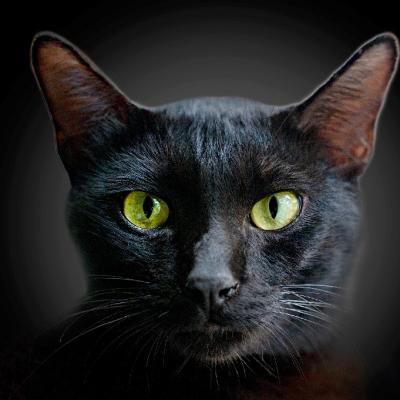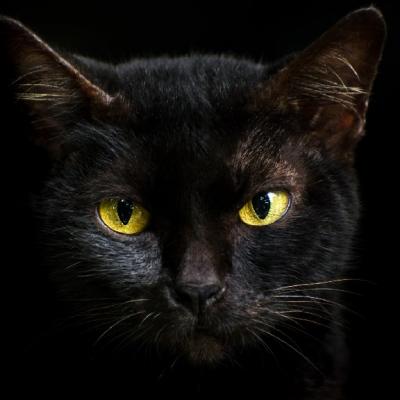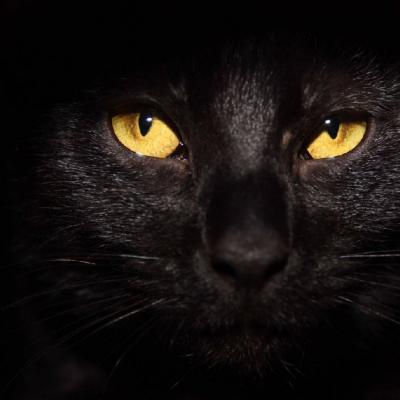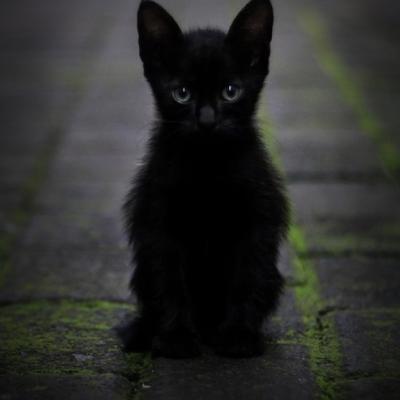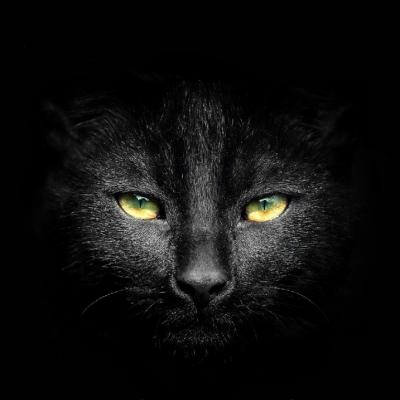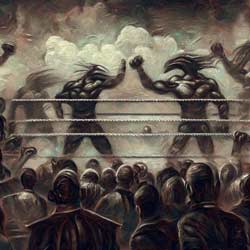 Embarking on a comprehensive exploration of H.P. Lovecraft and R.H. Barlow's "The Battle that Ended the Century," this review illuminates the depths of satire and humor found in the story, divergent from Lovecraft's typical cosmic horror. It invites readers to view this tale as a window into Lovecraft's literary circle, his perspective on writing, and a reflection of his humor, enriching the understanding of his oeuvre.
Embarking on a comprehensive exploration of H.P. Lovecraft and R.H. Barlow's "The Battle that Ended the Century," this review illuminates the depths of satire and humor found in the story, divergent from Lovecraft's typical cosmic horror. It invites readers to view this tale as a window into Lovecraft's literary circle, his perspective on writing, and a reflection of his humor, enriching the understanding of his oeuvre.
Plunging into the vast cosmos of H.P. Lovecraft's literary universe, one encounters an oddity entitled "The Battle that Ended the Century," penned in collaboration with R.H. Barlow. This is Lovecraft and Barlow at their most irreverent, mocking the seriousness of their contemporary Weird Tales tradition, and offering a different, yet essential perspective on Lovecraft’s creative repertoire. Rather than the chthonic depths or interstellar voids, the tale takes us into a parodic arena of fantastic pugilism.
"The Battle that Ended the Century" is a tumultuous tale drenched in satire, its primary intent being to mock and caricature. Among the fighters, allusions to various authors and figures in Lovecraft's circle of acquaintances can be discerned. The story, thus, serves as a mirror held up to the amateur press circles and Lovecraft's peers, a tool of sardonic critique that adds a new dimension to Lovecraft’s often perceived austere persona.
However, some critics argue that this departure from Lovecraft's customary macabre storytelling obscures his skill, with the tale deemed a curiosity rather than a significant part of his oeuvre. They decry the lack of the cosmic horror that Lovecraft so masterfully wove into his other narratives. Despite this, it is crucial to recognize that even in this humour, Lovecraft showcases his erudition, through the depth of reference and allusion, a talent not to be dismissed lightly.
The text is teeming with symbolism. The chaotic melee in the ring symbolizes the tumultuous literary world, while the bizarre, often grotesque descriptions of the combatants can be seen as Lovecraft's commentary on the absurdity of literary pretensions and rivalries. The irreverence seeping from the narrative attests to Lovecraft's capacity for humor, a lesser-known facet of his literary genius.
Compared to Lovecraft's more famous works like "The Call of Cthulhu" or "At the Mountains of Madness," "The Battle that Ended the Century" might appear insignificant. However, this seemingly whimsical story provides invaluable insights into Lovecraft's relationships within the literary community and his thoughts on writing. It may lack the cosmic horror of his main body of work, but it still captures the spirit of the period and his personality.
As with many of Lovecraft’s lesser-known works, "The Battle that Ended the Century" encourages a broadening of understanding regarding the scope of his literary contributions. To appreciate the depths of Lovecraft’s literary acumen, one must consider these outliers as a vital part of his oeuvre. They offer a more rounded portrayal of a man often pigeonholed into the cosmic horror genre.
In conclusion, while "The Battle that Ended the Century" might be a departure from the dark, alien landscapes that Lovecraft is typically associated with, it demonstrates the breadth of his creativity and his capacity for satire. It is a fascinating glimpse into Lovecraft's world, revealing a man with a keen sense of humor, a sharp pen, and a profound understanding of the literary world around him.
References:
- Cannon, P. (2006). "'The Battle That Ended the Century': A Critical Commentary." In The Lovecraftian: Studies in Horror Literature (pp. 153-166). Wildside Press.
- de Camp, L. S. (1975). H.P. Lovecraft: A Biography. Arkham House.
- Joshi, S. T. (2000). H.P. Lovecraft: A Life. Necronomicon Press.
- Joshi, S. T. (2009). "'The Battle That Ended the Century': A Reconsideration." In H.P. Lovecraft: The Man, the Monster, the Legend (pp. 169-182). Hippocampus Press.
- Schultz, D. E. (1997). The Cthulhu Mythos Encyclopedia. Revised and expanded edition. Llewellyn Publications.
- Davis, E. (2010). The Battle That Ended the Century. Mythos Tales.
Note: The works of H.P. Lovecraft are in the public domain.
The Battle that Ended the Century
(MS. Found in a Time Machine)
By H. P. Lovecraft
with R. H. Barlow
[Note: Barlow’s contributions are in brackets.]
On the eve of the year 2001 a vast crowd of interested spectators were present amidst the romantic ruins of Cohen’s Garage, on the former site of New York, to witness a fistic encounter between two renowned champions of the strange-story firmament—Two-Gun Bob, the Terror of the Plains, and Knockout Bernie, the Wild Wolf of West Shokan. [The Wolf was fresh from his correspondence course in physical training, sold to him by Mr. Arthur Leeds.] Before the battle the auguries were determined by the venerated Thibetan Lama Bill Lum Li, who evoked the primal serpent-god of Valusia and found unmistakable signs of victory for both sides. Cream-puffs were inattentively vended by Wladislaw Brenryk—the partakers being treated by the official surgeons, Drs. D. H. Killer and M. Gin Brewery.
The gong was sounded at 39 o’clock, after which the air grew red with the gore of battle, lavishly flung about by the mighty Texas slaughterer. Very shortly the first actual damage occurred—the loosening of several teeth in both participants. One, bouncing out from the Wolf’s mouth after a casual tap from Two-Gun, described a parabola toward Yucatan; being retrieved in a hasty expedition by Messrs. A. Hijacked Barrell and G. A. Scotland. This incident was used by the eminent sociologist and ex-poet Frank Chimesleep Short, Jr., as the basis of a ballad of proletarian propaganda with three intentionally defective lines. Meanwhile a potentate from a neighbouring kingdom, the Effjay of Akkamin (also known to himself as an amateur critic), expressed his frenzied disgust at the technique of the combatants, at the same time peddling photographs of the fighters (with himself in the foreground) at five cents each.
In round two the Shokan Soaker’s sturdy right crashed through the Texan’s ribs and became entangled in sundry viscera; thereby enabling Two-Gun to get in several telling blows on his opponent’s unprotected chin. Bob was greatly annoyed by the effeminate squeamishness shewn by several onlookers as muscles, glands, gore, and bits of flesh were spattered over the ringside. During this round the eminent magazine-cover anatomist Mrs. M. Blunderage portrayed the battlers as a pair of spirited nudes behind a thin veil of conveniently curling tobacco-smoke, while the late Mr. C. Half-Cent provided a sketch of three Chinamen clad in silk hats and galoshes—this being his own original conception of the affray. Among the amateur sketches made was one by Mr. Goofy Hooey, which later gained fame in the annual Cubist exhibit as “Abstraction of an Eradicated Pudding”.
In the third round the fight grew really rough; several ears and other appurtenances being wholly or partially detached from the frontier battler by the Shokan Shocker. Somewhat irritated, Two-Gun countered with some exceptionally sharp blows; severing many fragments from his aggressor, who continued to fight with all his remaining members. [At this stage the audience gave signs of much nervous excitement—instances of trampling and goring being frequent. The more enthusiastic members were placed in the custody of Mr. Harry Brobst of the Butler Hospital for Mental Diseases.]
The entire affair was reported by Mr. W. Lablache Talcum, his copy being revised by Horse Power Hateart. Throughout the event notes were taken by M. le Comte d’Erlette for a 200-volume novel-cycle in the Proustian manner, to be entitled Morning in September, with illustrations by Mrs. Blunderage. Mr. J. Caesar Warts frequently interviewed both battlers and all the more important spectators; obtaining as souvenirs (after a spirited struggle with the Effjay) an autographed quarter-rib of Two-Gun’s, in an excellent state of preservation, and three finger-nails from the Wild Wolf. Lighting effects were supplied by the Electrical Testing Laboratories under the supervision of H. Kanebrake. The fourth round was prolonged eight hours at the request of the official artist, Mr. H. Wanderer, who wished to put certain shadings of fantasy into his representation of the Wolf’s depleted physiognomy, which included several supernumerary details supplied by the imagination.
The climax came in round five, when the Texas Tearer’s left passed entirely through Battling Bernie’s face and brought both sluggers to the mat. This was adjudged a finish by the referee—Robertieff Essovitch Karovsky, the Muscovite Ambassador—who, in view of the Shokan Shocker’s gory state, declared the latter to be essentially liquidated according to the Marxian ideology. The Wild Wolf entered an official protest, which was promptly overruled on the ground that all the points necessary to technical death were theoretically present.
The gonfalons sounded a fanfare of triumph for the victor, while the technically vanquished was committed to the care of the official mortician, Mr. Teaberry Quince. During the ceremonies the theoretical corpse strolled away for a bite of bologna, but a tasteful cenotaph was supplied to furnish a focus for the rites. The funeral procession was headed by a gaily bedecked hearse driven by Malik Taus, the Peacock Sultan, who sat on the box in West Point uniform and turban, and steered an expert course over several formidable hedges and stone walls. About half way to the cemetery the cortège was rejoined by the corpse, who sat beside Sultan Malik on the box and finished his bologna sandwich—his ample girth having made it impossible to enter the hastily selected cenotaph. An appropriate dirge was rendered by Maestro Sing Lee Bawledout on the piccolo; Messrs. De Silva, Brown, and Henderson’s celebrated aria, “Never Swat a Fly”, from the old cantata Just Imagine, being chosen for the occasion. The only detail omitted from the funeral was the interment, which was interrupted by the disconcerting news that the official gate-taker—the celebrated financier and publisher Ivar K. Rodent, Esq.—had absconded with the entire proceeds. [This omission was regretted chiefly by the Rev. D. Vest Wind, who was thereby forced to leave unspoken a long and moving sermon revised expressly for the celebration from a former discourse delivered at the burial of a favourite horse.]
Mr. Talcum’s report of the event, illustrated by the well-known artist Klarkash-Ton (who esoterically depicted the fighters as boneless fungi), was printed after repeated rejections by the discriminating editor of the Windy City Grab-Bag—as a broadside by W. Peter Chef[, with typographical supervision by Vrest Orton.]. This, through the efforts of Otis Adelbert Kline, was finally placed on sale in the bookshop of Smearum & Weep, three and a half copies finally being disposed of through the alluring catalogue description supplied by Samuelus Philanthropus, Esq.
In response to this wide demand, the text was finally reprinted by Mr. De Merit in the polychromatic pages of Wurst’s Weakly Americana under the title “Has Science Been Outmoded? or, The Millers in the Garage”. No copies, however, remain in circulation; since all which were not snapped up by fanatical bibliophiles were seized by the police in connexion with the libel suit of the Wild Wolf, who was, after several appeals ending with the World Court, adjudged not only officially alive but the clear winner of the combat.
[Glossary of Names—Ed.
Two-Gun Bob—Robert E. Howard
Knockout Bernie, the Wild Wolf of West Shokan—Bernard Austin Dwyer, of West Shokan, N.Y.
Bill Lum Li—William Lumley
Wladislaw Brenryk—H. Warner Munn
D. H. Killer—David H. Keller
M. Gin Brewery—Miles G. Breuer
A. Hijacked Barrell—A. Hyatt Verrill
G. A. Scotland—George Allan England
Frank Chimesleep Short, Jr—Frank Belknap Long, Jr.
The Effjoy of Akkamin—Forrest J. Ackerman
Mrs. M. Blunderage—Margaret Brundage (artist for Weird Tales)
Mr. C. Half-Cent—C. C. Senf (artist for Weird Tales)
Mr. Goofy Hooey—Hugh Rankin (artist for Weird Tales)
W. Lablache Talcum—Wilfred Blanch Talman
Horse Power Hateart—Howard Phillips Lovecraft
M. le Comte d’Erlette—August Derleth (author of Evening in Spring)
J. Caesar Warts—Julius Schwartz
H. Kanebrake—H. C. Koenig (employed by the Electrical Testing Laboratories)
H. Wanderer—Howard Wandrei
Robertieff Essovitch Karovsky—Robert S. Carr
Teaberry Quince—Seabury Quinn
Malik Taus, the Peacock Sultan—E. Hoffmann Price
Sing Lee Bawledout—F. Lee Baldwin
Ivor K. Rodent—Hugo Gernsback
Rev. D. Vest Wind—Unknown
Klarkash-Ton—Clark Ashton Smith
Windy City Grab-Bag—Weird Tales
W. Peter Chef—W. Paul Cook
Smearum & Weep—Dauber & Pine
Samuelus Philanthropus—Samuel Loveman
Mr. De Merit—A. Merritt (author of The Dwellers in the Mirage)
Wurst’s Weekly Americana—Hearst’s American Weekly]

